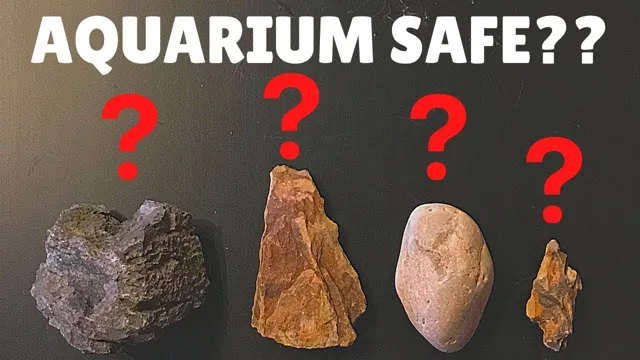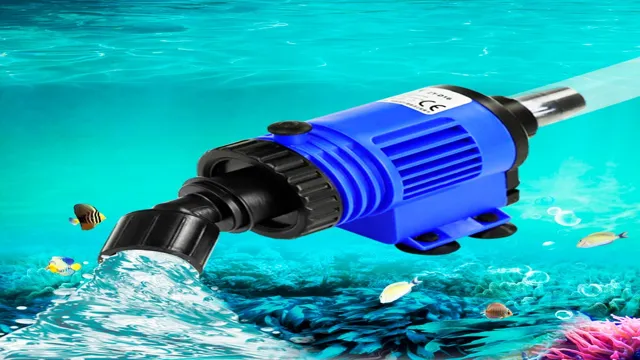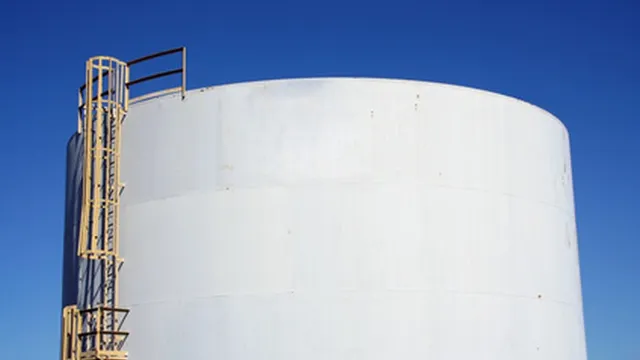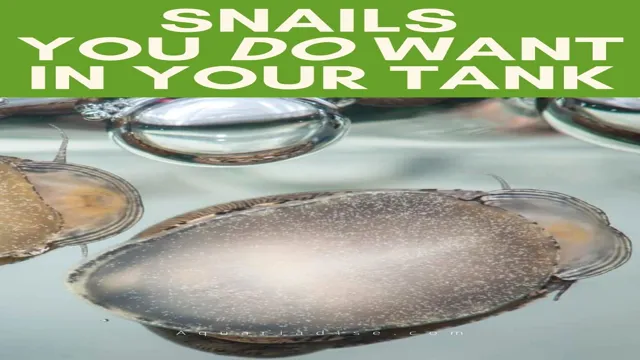Adding rocks to your aquarium can provide a natural-looking environment for your fish while also serving as a hiding place and surface for beneficial bacteria to grow. However, not all rocks are suitable for aquariums. Some rocks can disrupt the water chemistry, leach harmful substances and cause harm or even death to your aquatic pets.
So, how can you check if the rocks you’ve picked are safe for your aquarium? First, you need to understand the type of rocks that are safe to use in aquariums. Generally, inert rocks like granite, lava rocks, and quartz are considered safe as they do not alter the water chemistry. On the other hand, rocks rich in minerals like limestone, slate, and sandstone can increase the hardness and pH level of the water which can be harmful to fish and other aquatic organisms.
To ensure that the rocks you have picked are safe for your aquarium, always do the vinegar test. Simply drop a few drops of vinegar onto the rock surface. If it bubbles, fizzes or dissolves, it is not safe for use in aquariums as it indicates that the rock contains minerals that can alter the water chemistry.
If there is no reaction, the rock is most likely safe to use in your aquarium. It’s important to remember that not all rocks are the same and even rocks considered safe should be cleaned thoroughly before use. Always rinse your rocks with water, scrub any dirt or debris off the surface and let it soak in a bucket of water for a few days to remove any remaining impurities.
With these simple steps, you can ensure that your aquarium rocks are safe, making sure that your aquatic pets thrive in a natural, healthy environment.
Why Checking Rock Safety is Important
If you’re setting up an aquarium and planning to include rocks, it’s crucial to know how to check if the rocks you want to use are safe for aquatic life. Certain types of rocks may contain harmful substances like heavy metals or chemicals that can harm your fish and other aquatic creatures. Before adding rocks to your aquarium, check them carefully for any signs of damage, cracks, or sharp edges that could harm your aquatic pets.
Additionally, it’s important to research the types of rocks that are safe for aquarium use and to avoid using rocks that are known to leach harmful substances into the water. By taking these precautions, you can ensure that your aquarium is set up in a way that is safe and healthy for all of its inhabitants. Remember to always prioritize the safety of your aquatic pets when adding rocks or other decorations to your aquarium.
Protecting Fish and Other Aquatic Life
Protecting Fish and Other Aquatic Life is crucial for maintaining the balance of our ecosystem. Checking the safety of rocks in the water is a critical aspect that is often overlooked. It is essential to check if the rocks in the water are stable and secure to avoid any harm to fish or other aquatic life.
Unstable rocks can cause damage to the sensitive ecosystems in the water and can lead to the release of harmful pollutants, affecting the water quality and endangering aquatic life. Additionally, unstable rocks can cause injuries to the animals, leading to their death or prolonged suffering. Therefore, it is crucial to be responsible when visiting areas near the water and avoid tampering with the natural environment.
By taking the necessary measures to ensure rock safety, we can protect the aquatic life and preserve our planet’s natural resources.

Preventing Harmful Chemical Imbalances
Rock Safety Checking the safety of rocks is of great importance in preventing harmful chemical imbalances. While it may seem like a trivial task, the composition of rocks can have a major impact on the environment and the health of living organisms. Dangerous chemicals such as lead, arsenic, and mercury can be present in rocks, particularly those that have been mined or exposed to industrial waste.
The process of checking rock safety involves testing the composition of the rock for the presence of these chemicals and ensuring that they do not exceed safe levels. This is crucial as exposure to these chemicals can lead to a range of health problems, including cancer and neurological damage. By checking the safety of rocks, we can prevent harmful chemical imbalances and ensure a safer and healthier environment for all.
Types of Rocks to Avoid in Aquariums
If you’re planning to use rocks in your aquarium, it’s important to know which types of rocks to avoid. Some rocks can cause harm to your aquatic pets, alter the water chemistry, and even potentially lead to health issues for humans. To ensure that your rocks are safe for aquarium use, you can conduct a simple test at home.
Start by pouring vinegar onto the rock and observing if it reacts. If the rock fizzes or bubbles, it’s not safe for aquarium use as it contains carbonate minerals that can disrupt the pH levels in your tank. Additionally, avoid using rocks that are too porous or contain excessive amounts of metals as these can also harm your aquatic life.
Always do your research and choose rocks that are inert, non-reactive, and free from any harmful minerals to keep your aquarium happy and healthy. (See Also: How to Arrange Aquarium Plants: Tips and Tricks for a Beautiful Underwater Garden)
Non-Inert Rocks to Avoid
When setting up an aquarium, it’s important to choose the right kind of rocks to ensure the health and safety of your aquatic pets. There are certain types of rocks that you should avoid, such as non-inert rocks. What are non-inert rocks, you ask? Well, they are rocks that can change the pH and hardness of your aquarium’s water, which can be harmful to your fish and other aquatic creatures.
Some common non-inert rocks include limestone, coral, and marble. These rocks contain minerals and organic matter that can dissolve in water and alter its chemical composition. So, it’s best to stick with inert rocks like quartz, basalt, and granite that won’t affect the water parameters and are safe for your aquatic pets.
Overall, it’s important to do your research and choose the right rocks for your aquarium to create a healthy and thriving underwater ecosystem.
Rocks that May Release Toxins or Change Water Chemistry
When it comes to setting up an aquarium, choosing the right rocks to decorate it with is crucial. Some rocks may look great, but they can also release toxins or change the water chemistry, which could harm your fish and other aquatic creatures. One type of rock to be wary of is limestone.
Limestone can raise the pH level of your aquarium water, making it more alkaline and potentially harmful to your fish. Similarly, rocks that contain heavy metals or minerals such as copper can leach into your aquarium water and poison your fish. Other rocks that should be avoided include shale and sandstone, as they can break down easily and create sharp edges that could harm your fish.
So, when selecting rocks for your aquarium, choose carefully and opt for ones that have been pre-tested and are known to be safe for aquatic life.
How to Test Rocks for Aquarium Safety
If you’re planning to add rocks to your aquarium, it’s crucial to ensure that they are safe for your aquatic pets. Some rocks may contain harmful substances like heavy metals or minerals that can leach into the water and harm your fish. To check if rocks are safe for your aquarium, you can perform a simple test.
First, clean the rocks thoroughly by washing them in warm water. Then, pour some vinegar over the rocks and observe them closely. If the rocks are safe, they won’t react with the vinegar and will remain unchanged.
However, if bubbles or fizzing occur, it indicates that the rock is unsuitable for the aquarium. This bubbling is a sign of the rock reacting with acidic substances such as vinegar and may indicate the presence of harmful minerals that could harm your fish. Therefore, always test rocks before adding them to your aquarium to ensure the safety of your aquatic pets.
Acid Test for Carbonate Minerals
Testing Rocks for Aquarium Safety Using Acid Test for Carbonate Minerals If you’re looking to add rocks to your aquarium, it’s important to test them for safety first. One way to do this is to use the acid test for carbonate minerals. This test involves placing a drop of acid (such as hydrochloric acid) onto the rock.
If the rock contains carbonate minerals, the acid will cause it to fizz or bubble. This reaction indicates that the rock may raise the pH levels of your aquarium, potentially harming your fish and other aquatic life. If the rock does not react to the acid, it should be safe to use in your aquarium.
Keep in mind that other factors (such as heavy metals) may also pose a threat to aquatic life, so it’s always best to research any rocks before adding them to your aquarium. By using the acid test for carbonate minerals, you can ensure that you’re creating a safe and healthy environment for your aquatic pets.
Muriatic Acid Test for Non-Carbonate Minerals
Aquarium Safety As a responsible aquarium owner, it’s essential to test all rocks and minerals before adding them to your tank. One of the most effective ways to test non-carbonate minerals is to use the muriatic acid test. This test can be done easily at home, and all you need is some safety equipment like gloves and goggles and a bottle of muriatic acid.
To begin, you should crush a small sample of the rock or mineral you plan to test. Place the sample in a glass container and cover it with the muriatic acid. Be sure to wear protective gear, as this acid can cause burns and is hazardous. (See Also: How to Keep Your Aquarium Water Cool in Hot Weather: Tips and Tricks)
If you notice bubbles forming, it indicates that the rock contains carbonate minerals, which are unsafe for your aquarium. However, if there are no bubbles, it means the rock is safe for your tank. It’s important to note that the muriatic acid test is not suitable for all types of minerals.
For example, if the rock in question is a volcanic rock or igneous rock, this test won’t be effective, and you should seek other testing methods. Lastly, make sure to rinse the sample thoroughly with water after conducting the test to neutralize any remaining acid. By following these guidelines, you can ensure that the rocks in your aquarium are safe and will not harm your fish or other aquatic creatures.
Remember, safety is paramount when it comes to aquariums, and it’s better to be safe than sorry.
Boiling Test for Rocks that May Absorb Water
If you’re planning to set up an aquarium, it’s important to choose the right kind of rocks to ensure the safety of your aquatic pets. Some rocks are known to absorb water, which can result in changes in the pH level of the tank. To test if a rock is safe for aquarium use, you can perform the boiling test.
First, wash the rock thoroughly and place it in a pot of cold, clean water. Slowly heat the water and let it boil for at least 15 minutes. Afterward, let the water cool down and test its pH level.
If there are no significant changes, you can use the rock in your aquarium. Remember, rocks with high levels of calcium or other minerals can also affect the pH level of the water, so it’s best to test them before adding them to your tank. By performing these simple and easy tests, you can ensure the safety of your aquatic pets and provide them with a happy and healthy environment.
Final Tips for Safe Rock Selection
When selecting rocks for your aquarium, it’s crucial to ensure they are safe for your aquatic friends. One simple way to check if a rock is safe is to pour a few drops of vinegar on it and observe the reaction. If the rock starts to bubble and fizz, it may not be safe for your aquarium as it contains minerals that can affect the water chemistry.
Another important factor to look out for is sharp edges or rough surfaces, as these can harm your fish or scratch the glass of your tank. It’s also best to avoid rocks that have been treated with chemicals or painted, as these substances can be toxic to aquatic life. When in doubt, it’s always better to err on the side of caution and choose rocks specifically designed for aquarium use.
With these simple tips, you can ensure the safety of your aquatic pets and create a beautiful and natural-looking environment for them to thrive in.
Avoid Rocks with Sharp Edges or Points
When it comes to selecting rocks for your landscaping or construction project, it’s important to consider safety as well as aesthetics. One crucial tip to keep in mind is to avoid rocks with sharp edges or points. Not only can these types of rocks be dangerous to handle, but they can also pose a hazard to pets and wildlife in the area.
Instead, opt for smoother, more rounded rocks or stones. These types of rocks are not only safer, but they can also add a more natural, organic feel to your project. So when you’re selecting rocks for your next project, keep safety in mind and choose wisely!
Rinse Rocks Thoroughly Before Use
When it comes to selecting rocks for your aquarium, it’s important to take safety precautions to ensure the health and well-being of your fish. One final tip to keep in mind is to rinse any rocks thoroughly before use. This is particularly important if you are using rocks that you collected from a natural body of water or purchased from a store.
Rinsing the rocks helps to remove any dirt, debris, bacteria, or harmful chemicals that may be present on their surface. This step also helps to prevent the buildup of algae and other unsightly substances in your aquarium. So, take the time to rinse your rocks thoroughly before adding them to your tank, and your fish will thank you for it!
Start with a Small Amount of Rocks and Monitor Water Parameters
When selecting rocks for your aquarium, it’s important to start with a small amount and closely monitor your water parameters. This can prevent any sudden changes in the environment that could harm your fish. Additionally, it’s essential to choose rocks that won’t alter the pH balance or hardness of the water. (See Also: How to Make Your Own Aquarium Siphon: A Step-by-Step Guide for Beginners)
Rocks like limestone, which can add to the hardness of your water, should be avoided. Instead, consider selecting inert rocks like slate, quartz, or lava rock. These rocks won’t change the water quality and will provide a safe and stable environment for your aquatic pets to thrive in.
Remember, taking the time to carefully select and monitor the rocks you add to your aquarium will help ensure the health and happiness of your fish.
Conclusion
So, if you’re looking to add some rockin’ décor to your aquarium, it’s important to know how to determine if those rocks are safe to swim with. Remember to avoid any rocks that may contain toxins, such as copper or lead, and always opt for non-porous materials. Keep an eye out for any signs of deterioration or breakage and give those rocks a proper cleaning before they make a splash in your aquarium.
With these tips in mind, your fishy friends will be living the rockstar life in a safe and stylish aquatic environment!”
FAQs
What types of rocks are safe for aquariums?
There are several types of rocks that are safe for aquariums including lava rock, quartz, and granite. It is important to avoid rocks that may alter the pH levels or release harmful toxins into the water.
How can I test if a rock is safe for my aquarium?
To test if a rock is safe for your aquarium, you can perform a vinegar test. Pour some vinegar onto the rock and if it fizzes, it is not safe to use in your aquarium. Safe rocks will not react to vinegar.
Can I use beach rocks in my aquarium?
It is not recommended to use beach rocks in your aquarium as they may contain harmful bacteria or pollutants from the sea water. It is best to use rocks specifically marketed for aquarium use.
Should I boil rocks before adding them to my aquarium?
It is recommended to boil rocks for at least 20 minutes before adding them to your aquarium to kill any potential bacteria or parasites that may be present.
How often should I check the rocks in my aquarium?
It is important to regularly check the rocks in your aquarium for any signs of deterioration or harmful substances. It is recommended to check the rocks each time you perform a water change.
Can I use rocks from my garden in my aquarium?
It is not recommended to use rocks from your garden in your aquarium as they may contain harmful pesticides or fertilizers that can be toxic to your fish.
Are all colors of rocks safe for aquariums?
No, some colored rocks may contain dyes or chemicals that can be harmful to your aquarium. It is best to stick to natural colored rocks like brown, grey, and black.







